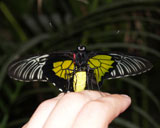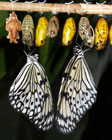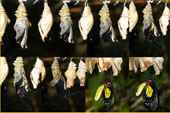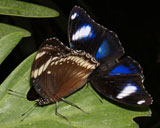On 2007, the exportation of the natural tropical will open the territory of Sofia garden |
 |
|
A unique specimen of a tropical butterfly, gynandromorphy
Troidеs radamantus, has come into the world in
“The tropical butterflies garden “. In the world’s
practice of keeping such butterflies it is very
rare. It is one gynandromorphy specimen of ninety
thousand cases. Gynandromorphy butterflies are
original semi male and semi female, when one part
of a body is completely male and other is female.
Natural distinctions of sex become apparent in
full measure right up to the shape of antennas.
|
|
| A butterfly’s life cycle is
egg-caterpillar-pupa-butterfly-egg-caterpillar—pupa
and so on. At the pupa stage a metamorphosis happens:
a transformation of a wingless larva to an adult
winged insect. A “maturing” of a pupa or more
precisely of a butterfly in a pupa is allowed
to see with a naked eye. For example from the
beginning the Idea leuconoe pupas have an amber-golden
regular colour, then it grows darker and it is
possible to see some pattern and veins on the
new butterfly’s wings. |
|
 |
|
 |
|
The birth of a butterfly is really a
miracle! A thin covering of a pupa breaks,
Then You see antennas, a head and feet, which
are used by butterfly to catch on. Thus making
a great deal of efforts a butterfly releases rest
of an abdomen and wings. At first the wings are
small like convolute but very elastic. Just after
appearing in the world a butterfly is open to
injury. Its wings are damp and it cannot fly now.
Little by little wings straighten up, grow to
the right size and get dry in several hours. They
loose a resilience, grow stronger, obtain lightness,
and the butterfly may fly for the first time.
It is ready for looking for a partner and coupling. |
|
| Coupling (courting) Sometimes
striving for continuing of genus suppresses even
a main instinct of self-preservation. Making court
to partner the butterflies lose their vigilance.
First of all the butterflies recognise each other
by colour, size, shape of wings and smell, of
course. Some species (Papilionidae, Danaeidae)
make marriage dances on flight touching each other
with antennas. A female of other species sits
on a plant while a male dances in front of it
or keeps other male off defending its territory.
By showing of aggressiveness, a male may even
attack small birds or sufficiently danger insects.
After coupling (which may last for some hours),
a female flies away looking for feeding plant
(where future caterpillars will feed on) and lays
eggs. The cycle has completed. The butterflies
do not burden themselves with bringing children
up. |
|
 |
|
|
